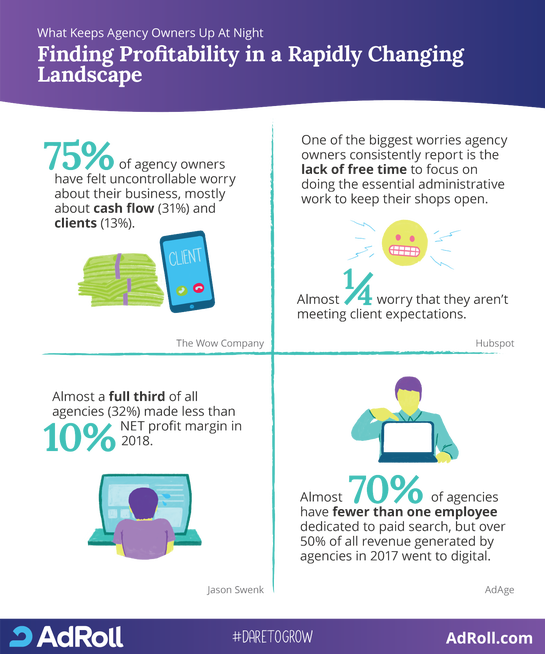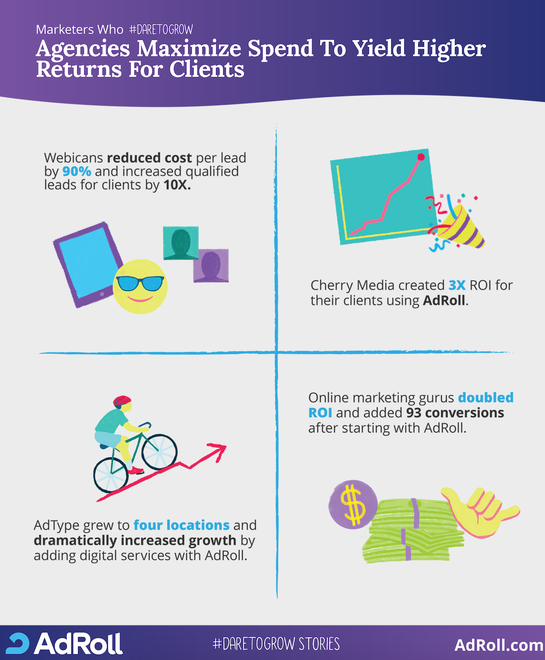On July 19, 2007, most of the world got their first-ever look inside a marketing and advertising agency, as Jon Hamm’s Don Draper drank and flirted and pitched his way to the top. AMC’s Mad Men made the agency world seem dark and sexy and exciting, full of shocking love triangles and unfortunate lawnmower accidents — one where an agency’s rise and fall was due entirely to the brilliant, troubled people running it.
Of course, the real world is usually far less exciting, and today's digital agency owners and employees know that most don’t go under because of creative disagreements and larger-than-life personalities. When agency owners lie in bed staring at the ceiling at 4am, they aren’t worried about a sudden firing by Lucky Strike Cigarettes over a romantic liaison gone wrong — they’re thinking about the mundane world of profitability, payroll, and doing good work for clients. Unsurprisingly, it turns out that running an agency is a lot less dramatic than the antics of Hamm and his co-stars, though perhaps no less stressful.
It’s natural to feel worried about the state of your agency — over 75% of agency owners in the UK reported that they’ve felt “uncontrollable worry about their business” in the last year. While the challenges facing real agency owners aren’t usually the stuff of great television, they are serious challenges. Many of them are linked: a lack of time, low profitability and cash flow, and the fear that they aren’t meeting client expectations. Many become self-fulfilling prophecies: excessive worrying about money leads to poor sleep which leads to poor work which leads to fewer clients.
Many more are driven by external factors, especially the rise in marketing-as-a-service platforms and programmatic ad buying, which reward those who adopt them while shrinking margins for agencies doing things the legacy way. For small and midsize agencies, these aren’t just passing problems — these are existential challenges to overcome.
![]()
Fortunately, these challenges are not insurmountable. We've seen a lot of partner agencies get over these humps, and have collected a bevy of tips to help your digital agency grow in today's world.
Focus on the Process, Not Just the Result
One of the biggest worries agency owners consistently report is the lack of free time to focus on doing the essential administrative work to keep their shops open. This is followed closely by profitability, cashflow, and the belief that they aren’t meeting client expectations. What many don’t consider, though, is that all of these problems are linked together, and often stem from not enough time spent on the processes that power your agency. It might seem like you’re always so busy putting out fires that you don’t have the time to lay down a solid foundation. Realistically, there will always be fires to put out, and without that foundation, they’ll multiply faster than you can put them out.
Building an agency that can stand the test of time requires a solid foundation. Besides offering great service and results to clients, growth requires careful planning and management, and that means putting aside time regularly to not just deal with admin tasks, but plan for the future to make sure your processes are strong.
AdType, a European digital agency, was able to line up their service offerings and provide knockout results, but it was their dedication to scalable growth that enabled them to expand to four offices across Europe. Building well-thought-out procedures in advance and constantly refining them gave them the freedom to focus on client work without having to do double-duty as firefighters.
Keep Your Eyes On The Prize
It’s easy for agencies to focus on high-level metrics — revenues, clients signed, visitors, share of voice. This is true both for internal growth and client results. Those numbers are large and exciting and get everyone pumped up. Eventually, though, doing good work and keeping the doors open means drilling down and providing bottom-line results. For many agencies, the road to profitability is a difficult one — a third operate on less than 10% net margin. For client work, that can be even more problematic — strong top-of-funnel numbers can mask growing dissatisfaction from clients when they fail to see strong profitability despite glowing monthly reports.
The only solution is to always be cognizant that marketing activities don’t exist in a vacuum. Whether you’re working on growing and expanding your agency, or on delivering results to clients, it’s important to stop and do a sanity check every once in a while to make sure the results you’re getting are the important ones. This is especially true for clients, who rarely bring up concerns before they’ve turned into major problems. Be sure to keep open lines of communication with clients to encourage this type of analysis.
Cherry Media Group is a good example of this. Their clients mentioned wanting to see some stronger returns on great top-line results. Cherry Media had the ability to drill-down and put together a more complete customer profile — and turn more visitors into customers for clients. As a result, they increased client ROI 3X, leading to a long and happy relationship.
Evolve, Evolve, Evolve
In a recent Agency Report by Ad Age, over 50% of all agency revenue was digital (for more, see this post on how to become digital-first). Despite that, almost 70% of marketing agencies have either just one employee or no employees managing paid search. Sustainable growth requires proper staffing and resourcing, and agencies can’t afford to ignore digital anymore. Not devoting proper attention to digital is tantamount to throwing your hands up in the air and saying you’re giving up on half the market and is a mistake that legacy agencies can’t afford to make anymore.
Webicans had been offering a suite of traditional offline and digital agency services to clients for years. As a full-service agency that came of age with the internet, it was quick to realize that the winds were shifting and traditional advertising and media buying services were going the way of the encyclopedia. They prioritized a digital-first approach, adding technology-powered tools to help them offer next-generation offerings quickly. Moving past the mailer, Webicans embraced the omnichannel, full-funnel digital approach, and were able to decrease its median client CPA by $400, a 90% reduction. That meant happier clients, larger margins, and a happier agency owner.
![]()
Last updated on April 23rd, 2025.


